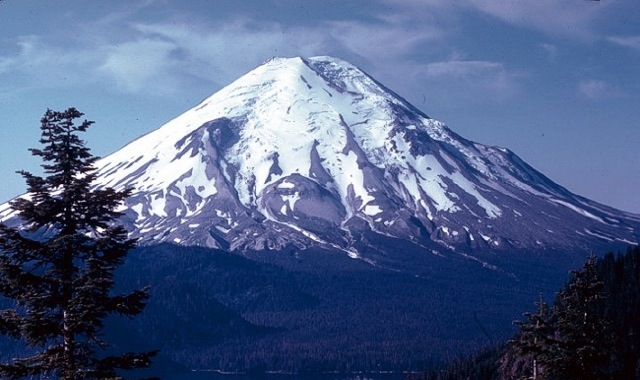
Mount St. Helens, Washington, as seen from Spirit Lake, 1982
U.S.G.S. Cascades Volcano Observatory Archives
The Sierra Club was founded in 1892 with a mission that was very similar to what we still hold true to today. . . "To explore, enjoy, and render accessible the mountain regions of the Pacific Coast; to publish authentic information concerning them; to enlist the support and co-operation of the people and the Government in preserving the forests and other natural features of the Sierra Nevada Mountains."
Since then, the club has been an active participant in the creation and protection of the national parks we enjoy today - as well as the creation of the National Park Service during Woodrow Wilson’s presidency. The well known photographer Ansel Adams was a Sierra Club Board member.
During the 1970’s, the Nixon Administration established the Environmental Protection Agency while Congress established much of the environmental legislation that protects air and water quality. The Sierra Club’s role in influencing these outcomes can’t be overstated. At the same time, the club began tracking the environmental records of elected officials, appointed its first Political Director, and started endorsing candidates who supported the club’s values. See Sierra Club’s history.
It was within this framework that the Loo Wit Group was formed in the mid-1970’s to give the Sierra Club a local voice in SW Washington. Historically, the Loo Wit group’s efforts focussed on education, outings, conservation, and political activism. The group’s motto was - “Always in a team with mentoring attached; lots of room for volunteerism.”
Past conservation focused on the need for clean energy and transportation. The initial Columbia River Crossing effort was backed by the Loo Wit group because it contained planning for increased bike traffic, foot traffic, light rail and a variety of ride sharing vehicles (bus, etc.).
Watershed use and protection especially focused on the state’s Growth Management Act and Clark County’s action plan to support / implement it. We worked with Friends of Clark County and other groups to educate on water, stream, and fish protection.
The St Helens copper mine has been successfully challenged three times by a local coalition lead by the Gifford Pinchot Task Force (now the Cascade Forest Conservancy) and Loo Wit was always (and still is) involved.
Prior to the now well known oil terminal fight, Loo Wit had begun the coal train education program which transitioned into the fight to shut down coal / oil / liquid natural gas / methanol terminals. The success of the oil terminal fight was based on a strong coalition of local like minded groups of which Loo Wit is honored to be a part.
One of our local Loo Wit legends is Roger Cole. He was part of the original "dirty dozen" which consisted of a coalition of people from Loo Wit and other local organizations who fought to protect Pacific Northwest old growth forests. This was their passion and their shared interests were so powerful! Loo Wit’s roots in protecting forests run deep and we are proud of the impact we have made in our community.
The name Loo Wit is derived from Native American myth - the name for Mt St Helens. The following account of the myth is from the Oregon State University website.
“According to the lore of the Native American tribes of the Pacific Northwest, long ago a huge landslide of rocks roared into the Columbia River near Cascade Locks and eventually formed a natural stone bridge that spanned the river. The bridge came to be called Tamanawas Bridge, or Bridge of the Gods.
In the center of the arch burned the only fire in the world, so of course the site was sacred to Native Americans. They came from north, south, west, and east to get embers for their own fires from the sacred fire.
A wrinkled old woman, Loowitlatkla ("Lady of Fire,") lived in the center of the arch, tending the fire. Loowit, as she was called, was so faithful in her task, and so kind to the Indians who came for fire, that she was noticed by the great chief Tyee Sahale.
He had a gift he had given to very few others -- among them his sons Klickitat and Wyeast -- and he decided to offer this gift to Loowit as well. The gift he bestowed on Loowit was eternal life. But Loowit wept, because she did not want to live forever as an old woman.
Sahale could not take back the gift, but he told Loowit he could grant her one wish. Her wish, to be young and beautiful, was granted, and the fame of her wondrous beauty spread far and wide.
One day Wyeast came from the land of the Multnomahs in the south to see Loowit. Just as he arrived at Tamanawas Bridge, his brother Klickitat came thundering down from the north. Both brothers fell in love with Loowit, but she could not choose between them. Klickitat and Wyeast had a tremendous fight. They burned villages. Whole forests disappeared in flames.
Sahale watched all of this fury and became very angry. He frowned. He smote Tamanawas Bridge, and it fell in the river where it still boils in angry protest. He smote the three lovers, too; but, even as he punished them, he loved them. So, where each lover fell, he raised up a mighty mountain.
Because Loowit was beautiful her mountain (St. Helens) was a symmetrical cone, dazzling white. Wyeast's mountain (Mount Hood) still lifts his head in pride. Klickitat, for all his rough ways, had a tender heart. As Mount Adams, he bends his head in sorrow, weeping to see the beautiful maiden Loowit wrapped in snow.”
Links • Newsletters • About Us • History